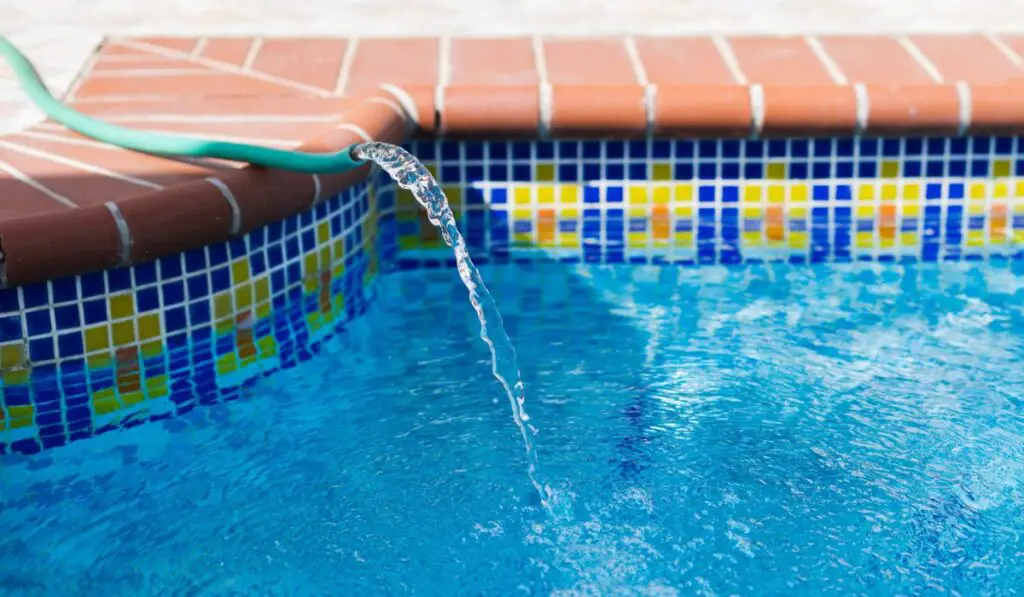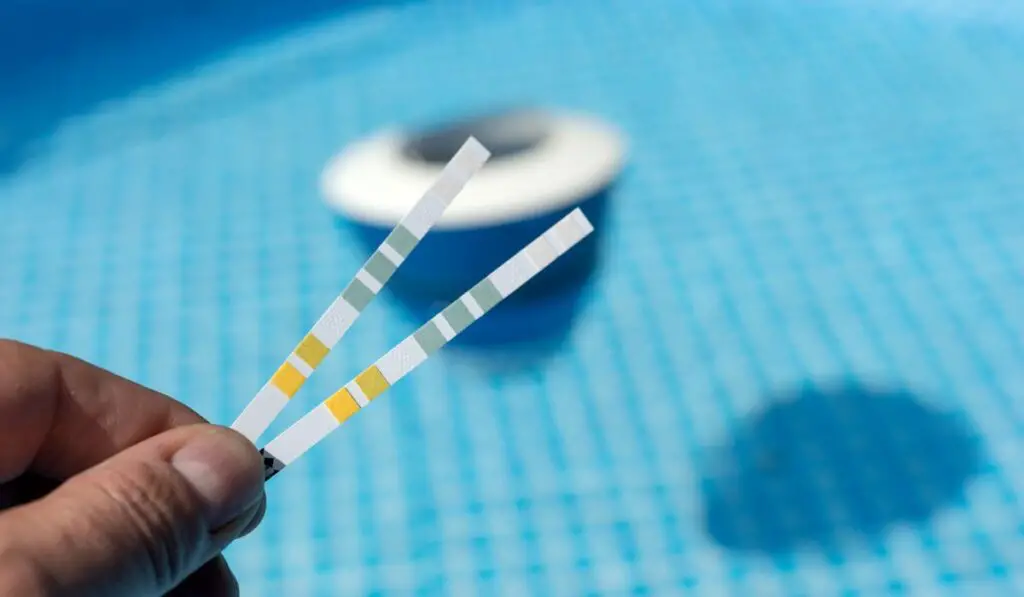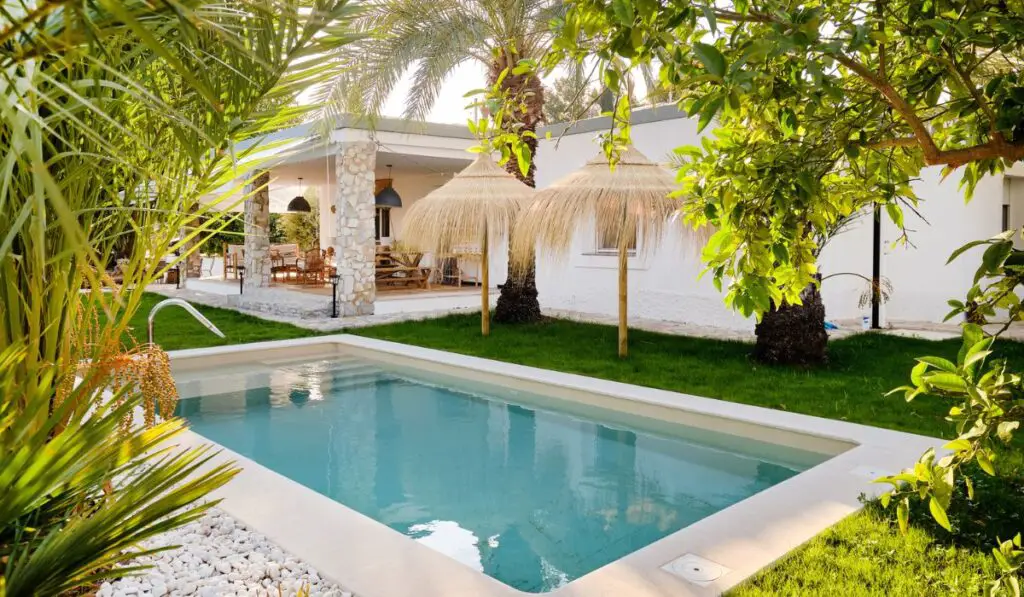Installing a swimming pool in your house certainly makes summertime more fun. However, if you’ve just filled a new pool with water, you may be wondering if it’s safe to jump right in. So, is it really necessary to shock a freshly filled pool?
There’s no need to shock a freshly filled pool if you’re sure the water source is clean. However, if the water source might be contaminated, it’s better to be safe than sorry. Test your water source before filling the pool, and be sure to check the chemical levels on a regular basis going forward.
You may think that maintaining a pool is a tough task, but if you keep up with regular checks and maintenance, it should be a breeze. Let’s take a closer look at what needs to be done once you’ve filled your pool and how to test the pH levels on a regular basis.
Should You Shock a Freshly Filled Pool?

Whenever you’re getting ready for a swim in your pool, it’s important to ensure that the water is free of bacteria and other contaminants.
Shocking a pool involves using liquid chlorine to prevent the growth of algae, bacteria, and other infestations.
But is shocking really necessary if you’ve just filled your pool? Pool experts have different opinions on this matter.
Some suggest that you don’t need to shock a new, freshly filled pool because the water may not be exposed to any bacteria, algae, or pollutants. You can also avoid shocking a freshly filled pool to prevent the risk of damaging the liner.
On the other hand, many owners do recommend that you should give some sort of shock treatment to your pool before going for a swim.
Here are some reasons why you may need to give a shock to your freshly filled pool:
The Water Quality May Be Bad
You need to assess the water before filling your new pool. If the water source isn’t clean and has a potential for contaminants, it’s best not to take any risks and shock your new pool.
If you’re 100% sure about the cleanliness of the water, however, then save yourself the trouble of shocking the pool and enjoy your swim.
Freshly Filled Pools Also Get Polluted
A freshly filled pool can easily get polluted when there are too many swimmers, especially if the swimmers haven’t showered before jumping in the pool. Sunscreen and other skin treatment chemicals can also easily come off while they’re swimming.
In such cases, it’s best to shock your new pool regularly to prevent potential health hazards and clear the pool of unwanted chemicals.
Your Pool May Have a Saltwater System
If your pool has a saltwater system, you need to shock it more frequently. Most people make the mistake of not shocking the pool because they think that the saltwater system gets the job done on its own.
However, this isn’t true, and a pool with a saltwater system also requires regular maintenance.
What You’ll Need to Treat a New Pool
You need to treat your pool on a weekly basis, especially during the swimming season. It’s also highly recommended that you get a professional to clean your pool monthly.
It’s important for you to keep the pool chemistry in check. You’ll have to ensure the water’s pH, chlorine, and hardness levels are all correct.
Here are some essential items that you need for treating your pool:
- Liquid chlorine (on Amazon) or chlorine tablets for quick chlorine adjustment
- Calcium used to adjust the hardness of the pool
- pH regulators (pH increaser and ph decreaser)
- Stain removers and scale preventers
- Cyanuric acid (on Amazon) to stop chlorine from burning during summer heat so that it can sanitize the pool effectively
- Algaecide (on Amazon) to prevent the growth of algae
- Clarifiers to help to clear pool water of dirt and debris
While you won’t need all of these chemicals to treat a newly filled pool, and some are only used for older and dirtier pools, it’s best to keep them on hand just in case you need them.
Sanitizers
All pool owners should have chlorine on hand since it’s the primary chemical you’ll need to treat your pool.
It’s an easy-to-use sanitizer that comes in different forms, such as chlorine granules, chlorine tablets, and liquid chlorine. You’ll easily find chlorine from any retail outlet.
Initially, you’ll need to add heavy doses of chlorine while circulating the water. During the shock dose, you need to be extra cautious and keep all the swimmers away from the pool. Also, remove all the pool equipment to prevent fading and damage.
Bromine is another sanitizer used to disinfect and clean warm water. It’s a very popular sanitizer among hot tub and spa owners, and you’ll need it for an indoor pool.
Keep in mind that you can’t use chlorine and bromine together in your pool. If you use one and want to use the other for a change, you’ll have to drain the water completely.
Alkalinity Adjusters
Ideally, the alkalinity in your pool should range from 100-140 parts per million (ppm). This range is good enough to keep the pH levels of your pool in check, and it also allows the chlorine to work effectively.
You can use chemicals like sodium bicarb to raise the alkalinity levels of your pool, while muriatic acid is commonly used to lower the pool’s alkalinity.
How to Test the pH Level
If you don’t keep the pH levels of your pool in check, the other chemicals that you add to the pool won’t work either. The pH of your pool should range from 7.2 to 7.8, and the ideal pH level is 7.4.
It’s important that you check the pH of your pool twice a week. If you use the pool frequently or your pool was exposed to heavy rainfall, you should test the pool’s pH more often.
You can check the pH of your freshly filled pool in different ways. Some pH testing methods include:
Using Testing Strips

Using test trips (on Amazon) is an easy way to check the pH of your swimming pool. Cyanuric acid test strips are convenient as they indicate slight changes in pH levels and help you accurately check the chemical balance of your pool.
Read the instructions on the testing strip container and submerge the strip in the pool water to check its pH level.
You’ll have to keep the strip submerged for a few minutes to get an accurate reading. When the strip changes its color, check the color change with the pH scale on the container.
Testing strips help you accurately determine your pool’s pH so you get an idea of how far it is from the ideal range. You can then make the necessary adjustments by adding an acidity or alkalinity regulator.
Using a Test Kit
If you prefer an accurate pH test instead of an estimated one, you’ll need to buy a test kit like this one (on Amazon). It’s more accurate than a testing strip because it uses a larger water sample.
A test kit comes with a test tube to collect the water sample from the pool. You’ll need to read the instructions on the kit to use it correctly. After filling the test tube with water, add the droplets of re-agent and wait for it to react with the water in the tube.
When the color changes, compare it to the color scale on the kit to measure the pH of your pool.
If you want to get a more accurate reading of your pool’s pH but don’t want to invest in an expensive electronic pH tester, a test kit is ideal.
Using an Electronic Tester
An electronic tester (on Amazon) will give you the most accurate reading of your pool’s pH level. You don’t have to compare colors with the scale, as is the case with testing strips and test kit containers.
Since there’s no estimation, you’ll get a more accurate reading with an electronic tester.
The only problem that you’ll find with the electronic tester is that it’s expensive, but you may save in the long run as you don’t have to replace it over time, as you do with strips.
How Long Does It Take for a Pool to Cure?
If you have a new in-ground concrete pool, you’ll have to wait for it to cure before going for a swim. On average, the plaster takes 28 days to cure.
During this time, you’ll need to take care of the pool to ensure the curing process goes smoothly. In the first week, you’ll have to water it 3 to 4 times a day to prevent the concrete from cracking.
After this, you’ll have to keep the pool filled with water for about 30 days for it to cure completely.
How Long Should You Wait Before Swimming in a New Pool?

Getting a new pool is exciting, but before your first swim in your freshly filled new pool, you’ll have to be patient.
On average, you’ll have to wait seven days after curing before going for a swim in your new pool. Remember to check the chemical balance and pH of the water before jumping in, even if you haven’t used the pool yet.
Swimming too soon after filling a new pool can damage your skin as the water may still have a chemical imbalance.
